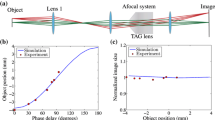Abstract
Fluorescence microscopy has been greatly contributed to the development of new science and technology in the field of microfluidics. In the case of centrifugal microfluidics, a microscale fluidic system is constructed on a spinning disk-shaped substrate; however, while microscopic stroboscopes have been developed, fluorescence imaging has not yet been demonstrated. This paper reports on the development of the first imaging technique that can observe small (micrometer) fluorescent objects on a spinning fluidic system. This technology is based on the combination of a Xe bulb strobe, a coaxial optics microscope, and a fluorescent optical filter. The observation of small particles on a spinning disk was demonstrated at both the bright field setting and the fluorescence setting. The system successfully demonstrates the observation of fluorescence particles on a spinning disk (at 3,000 rpm) and the sedimentation of particles in a suspension flow.







Similar content being viewed by others
References
Bhagat AAS et al (2008) Continuous particle separation in spiral microchannels using dean flows and differential migration. Lab Chip 8:1905–1914
Carlo DD (2009) Inertial microfluidics. Lab Chip 9:3038–3046
Carlo DD et al (2007) Continuous inertial focusing, ordering, and separation of particles in microchannels. Proc Natl Acad Sci USA 104:18892–18897
Ducreé J et al (2006) Multilamination of flows in planar networks of rotating microchannels. Microfluid Nanofluidics 2:78–84
Ducreé J et al (2007) The centrifugal microfluidic bio-disk platform. J Micromech Microeng 17:S103–S115
Duffy DC et al (1998) Rapid prototyping of microfluidic systems in poly(dimethylsiloxane). Anal Chem 70:4974–4984
Duffy DC et al (1999) Microfabricated centrifugal microfluidic systems: characterization and multiple enzymatic assays. Anal Chem 71:4669–4678
Furutani S (2010) Compact disk (CD)-shaped device for single cell isolation and PCR of a specific gene in the isolated cell. Anal Bioanal Chem 398:2997–3004
Gossett DR, Carlo DD (2009) Particle focusing mechanisms in curving confined flows. Anal Chem 81:8459–8465
Grumann M et al (2005) Visualization of flow patterning in high-speed centrifugal microfluidics. Rev Sci Instrum 76:025101
Haeberle S et al (2007) Centrifugal generation and manipulation of droplet emulsions. Microfluid Nanofluid 3:65–75
Honda N et al (2005) Simultaneous multiple immunoassays in a compact disc-shaped microfluidic device based on centrifugal force. Clin Chem 51:1955–1961
Huh D et al (2007) Gravity-driven microfluidic particle sorting device with hydrodynamic separation amplification. Anal Chem 79:1369–1376
Kang JH et al (2012) A combined micromagnetic-microfluidic device for rapid capture and culture of rare circulating tumor cells. Lab Chip 12:2175–2181
Kobayashi T et al (2010) Centrifugal separation device based on two-layer laminar flow in microchannels for high-throughput and continuous blood cell/plasma separation. Jpn J Appl Phys 49:077001
Lai S et al (2004) Design of a compact disk-like microfluidic platform for enzyme-linked immunosorbent assay. Anal Chem 76:1832–1837
Lee BS et al (2009) A fully automated immunoassay from whole blood on a disc. Lab Chip 9:1548–1555
Pamme N (2007) Continuous flow separations in microfluidic devices. Lab Chip 7:1644–1659
Petersson F et al (2007) Free flow acoustophoresis: microfluidic-based mode of particle and cell separation. Anal Chem 79:5117–5123
Riegger L et al (2006) Read-out concepts for multiplexed bead-based fluorescence immunoassays on centrifugal microfluidic platforms. Sens Actuators A 126:455–462
Seo J et al (2007) Membrane-free microfiltration by asymmetric inertial migration. Appl Phys Lett 91:033901
Tsukamoto M et al (2009) Cell separation by an aqueous two-phase system in a microfluidic device. Analyst 134:1994–1998
Tsutsui H, Ho CM (2009) Cell separation by non-inertial force fields in microfluidic systems. Mech Res Commun 36:92–103
Ukita Y, Takamura Y (2013) Control of secondary flow in concentrically traveling flow on centrifugal microfluidics. Microfluid Nanofluid. doi:10.1007/s10404-013-1194-9
Ukita Y et al (2012) Stacked centrifugal microfluidic device with three-dimensional microchannel networks and multifunctional capillary bundle structures for immunoassay. Sens Actuators B 166–167:898–906
Xia N et al (2006) Combined microfluidic-micromagnetic separation of living cells in continuous flow. Biomed Microdev 8:299–308
Yamada M et al (2004) Pinched flow fractionation: continuous size separation of particles utilizing a laminar flow profile in a pinched microchannel. Anal Chem 76:5465–5471
Acknowledgments
This research was supported by a JSPS KAKENHI grant for young scientists. The authors greatly appreciate the comprehensive technical support from Mr. Munenori Uno of the Center for Nano Materials and Technology JAIST in developing the spinning driver and stroboscope system.
Author information
Authors and Affiliations
Corresponding author
Rights and permissions
About this article
Cite this article
Ukita, Y., Takamura, Y. A new stroboscopic technique for the observation of microscale fluorescent objects on a spinning platform in centrifugal microfluidics. Microfluid Nanofluid 18, 245–252 (2015). https://doi.org/10.1007/s10404-014-1426-7
Received:
Accepted:
Published:
Issue Date:
DOI: https://doi.org/10.1007/s10404-014-1426-7




